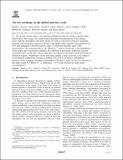Air-Sea Exchange in the Global Mercury Cycle

View/
Author
Strode, Sarah A.
Jaeglé, Lyatt
Selin, Noelle E.
Park, Rokjin J.
Mason, Robert P.
Slemr, Franz
Note: Order does not necessarily reflect citation order of authors.
Published Version
https://doi.org/10.1029/2006GB002766Metadata
Show full item recordCitation
Strode, Sarah A., Lyatt Jaegle, Noelle E. Selin, Daniel J. Jacob, Rokjin J. Park, Robert M. Yantosca, Robert P. Mason, and Franz Slemr. 2007. Air-sea exchange in the global mercury cycle. Global Biogeochemical Cycles 21: GB1017.Abstract
We present results from a new global atmospheric mercury model coupled with a mixed layer slab ocean. The ocean model describes the interactions of the mixed layer with the atmosphere and deep ocean, as well as conversion between elemental, divalent, and nonreactive mercury species. Our global mean aqueous concentrations of 0.07 pM elemental, 0.80 pM reactive, and 1.51 pM total mercury agree with observations. The ocean provides a 14.1 Mmol yr−1 source of mercury to the atmosphere, at the upper end of previous estimates. Re-emission of previously deposited mercury constitutes 89% of this flux. Ocean emissions are largest in the tropics and downwind of industrial regions. Midlatitude ocean emissions display a large seasonal cycle induced by biological productivity. Oceans contribute 54% (36%) of surface atmospheric mercury in the Southern (Northern) Hemisphere. We find a large net loss of mercury to the deep ocean (8.7 Mmol yr−1), implying a ∼0.7%/year increase in deep ocean concentrations.Terms of Use
This article is made available under the terms and conditions applicable to Other Posted Material, as set forth at http://nrs.harvard.edu/urn-3:HUL.InstRepos:dash.current.terms-of-use#LAACitable link to this page
http://nrs.harvard.edu/urn-3:HUL.InstRepos:3716278
Collections
- FAS Scholarly Articles [18292]
Contact administrator regarding this item (to report mistakes or request changes)


